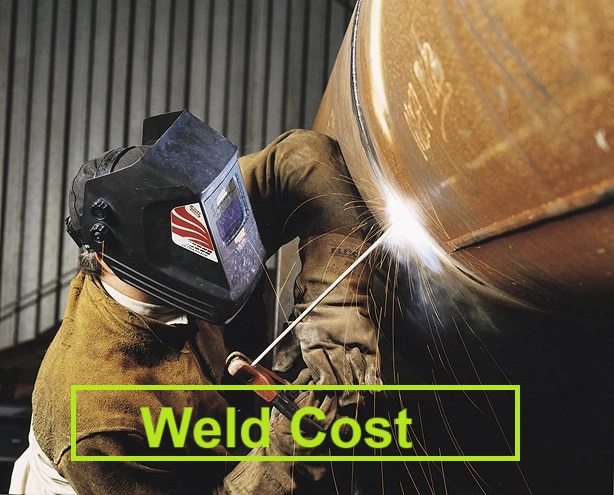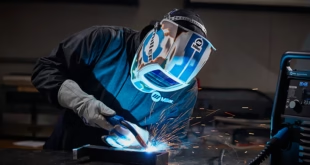Estimating Weld Cost
Introduction
Welding is a fundamental process in numerous industries, ranging from construction and manufacturing to automotive and aerospace. However, the success of any welding project hinges not only on skillful execution but also on accurate cost estimation. In this article, we delve into the critical aspect of estimating weld cost, exploring its importance and the myriad factors that influence it.
Understanding the Basics
Weld cost estimation requires a solid grasp of its fundamental concepts, including the definition of weld cost and the various components that comprise it.
Definition of Weld Cost
At its core, weld cost refers to the total expenditure associated with performing a welding operation. It encompasses all expenses incurred throughout the welding process, from the acquisition of materials to the labor required for welding and the overhead expenses associated with running a welding operation.

Components of Weld Cost
- Material Costs: Material costs represent the expenses incurred for the consumables used in the welding process. This includes the cost of welding electrodes, filler metals, shielding gases, fluxes, and any other materials essential for the welding operation. The type and quantity of materials required depend on factors such as the welding process, material type and thickness, joint design, and project specifications.
- Labor Costs: Labor costs encompass the expenses associated with the human resources involved in the welding process. This includes the wages or salaries paid to welders, welder helpers, and other personnel directly involved in welding activities. Labor costs are influenced by factors such as the skill level of the welders, project complexity, welding process efficiency, and labor productivity. Additionally, labor costs may include overhead expenses such as employee benefits, training, and insurance.
- Overhead Costs: Overhead costs refer to the indirect expenses incurred in running a welding operation that cannot be directly attributed to a specific welding project. These expenses include facility rent or mortgage payments, utilities, equipment depreciation, maintenance and repair costs, administrative expenses, insurance, and taxes. Overhead costs are allocated to individual welding projects based on factors such as machine hours, labor hours, or material usage.
Factors Affecting Weld Cost
Several factors significantly influence weld cost, encompassing material properties, welding techniques, joint configurations, and human expertise. Understanding these factors is crucial for accurate cost estimation and effective project management.
Material Type and Thickness
The material being welded and its thickness play a pivotal role in determining weld cost. Different materials, such as steel, aluminum, and stainless steel, have varying welding characteristics and require specific consumables and welding processes. Additionally, thicker materials necessitate higher welding currents, longer welding times, and greater consumable usage, leading to increased material costs and labor expenses.
Welding Process
The choice of welding process has a substantial impact on weld cost. Each welding process—whether it’s Gas Metal Arc Welding (GMAW), Gas Tungsten Arc Welding (GTAW), Shielded Metal Arc Welding (SMAW), or others—has unique advantages, disadvantages, and associated costs. Factors such as equipment costs, consumable expenses, labor requirements, and productivity levels vary significantly between welding processes, influencing overall project costs.
Welding Position
Welding can be performed in various positions, including flat, horizontal, vertical, and overhead. The welding position affects both material deposition rates and the accessibility of the weld joint, thereby influencing welding productivity and labor costs. Welding in challenging positions, such as overhead or vertical, may require additional setup time, specialized equipment, and skilled labor, potentially increasing project expenses.
Joint Design
The design of the weld joint significantly impacts weld cost. Complex joint configurations or intricate geometries may require more extensive preparation, additional fixturing, and longer welding times, leading to higher labor costs. Conversely, simple joint designs with straightforward geometries typically require less time and effort to weld, resulting in lower overall project expenses.
Welder Skill Level
The proficiency and expertise of the welder directly affect weld quality, productivity, and ultimately, weld cost. Highly skilled welders can complete tasks more efficiently, produce higher-quality welds with minimal defects, and troubleshoot welding challenges effectively. While skilled welders may command higher wages, their ability to optimize welding processes, minimize rework, and maximize productivity can lead to overall cost savings and improved project outcomes.
Methods of Estimation
Estimating weld cost is a critical aspect of project planning, and various methods exist to calculate it effectively. These methods range from traditional manual techniques to modern software-based solutions.
Manual Estimation Techniques
Manual estimation techniques involve calculating weld cost using predetermined formulas and parameters. Here are three common manual estimation methods:
- Cost per Inch/Foot: This method calculates weld cost based on the length of the weld joint. Welders determine the cost per inch or foot of welding, considering factors such as material costs, labor rates, and overhead expenses, and then multiply it by the total length of the weld joint.
- Cost per Pound: In this method, weld cost is calculated based on the weight of the consumables used in the welding process, such as electrodes or filler metals. Welders determine the cost per pound of consumables, including material costs, labor expenses, and overhead, and then multiply it by the total weight of consumables consumed during welding.
- Time-Based Estimation: Time-based estimation involves estimating weld cost by considering the time required to complete the welding operation. Welders calculate labor costs based on hourly rates, including wages, benefits, and overhead expenses, and then multiply it by the total welding time.
Software Tools for Automated Estimation
With advancements in technology, several software tools are available to automate the weld cost estimation process. These tools utilize algorithms and databases to generate accurate cost estimates quickly. Here’s an overview of popular welding cost estimation software:
- Welding Cost Calculator: This software allows users to input project parameters such as material type, thickness, welding process, and joint design, and then automatically calculates the estimated weld cost. It considers factors such as material costs, labor rates, welding efficiency, and overhead expenses to generate detailed cost breakdowns.
- Welding Management Software: Some comprehensive welding management software solutions include built-in cost estimation modules. These platforms streamline the entire welding process, from project planning and scheduling to cost tracking and reporting. Users can input project details, and the software generates accurate cost estimates based on predefined algorithms and industry standards.
- Cloud-Based Estimation Platforms: Cloud-based platforms offer online tools for weld cost estimation, accessible from any internet-enabled device. These platforms often feature user-friendly interfaces, customizable templates, and real-time collaboration capabilities, enabling seamless project estimation and management.
Best Practices for Accurate Estimation
Accurate estimation is crucial for effective project planning and budgeting in welding operations. To ensure precision and reliability in weld cost estimation, several best practices should be followed:
Gathering Accurate Data
Gathering precise and comprehensive data is the foundation of accurate estimation. This includes collecting detailed information on project requirements, such as material specifications, welding processes, joint designs, and project timelines. Additionally, accurate data regarding material costs, labor rates, equipment usage, and overhead expenses should be obtained. Utilizing historical project data and conducting thorough assessments of current project parameters contribute to more accurate estimations.
Considering Overhead Costs
Overhead costs, while indirect, play a significant role in determining overall project expenses. It’s essential to include overhead expenses, such as facility rent, utilities, equipment maintenance, administrative costs, and insurance, in the estimation process. Allocating a portion of overhead costs to individual welding projects based on relevant factors, such as machine hours or labor hours, ensures that these expenses are accounted for and reflected in the final cost estimate.
Accounting for Hidden Costs
In addition to direct material and labor costs, hidden costs can impact project profitability if not adequately accounted for. Hidden costs may include rework due to weld defects, material waste, equipment downtime, and project delays. It’s crucial to identify and quantify these hidden costs during the estimation process to prevent cost overruns and unexpected expenses. Conducting thorough risk assessments and incorporating contingency plans into the estimation helps mitigate the impact of potential hidden costs on project budgets.
Regularly Updating Estimation Methods
Welding technology, market dynamics, and project requirements evolve over time, necessitating regular updates to estimation methods. It’s essential to stay informed about industry trends, advancements in welding technology, and changes in material costs and labor rates. Updating estimation methods based on current data and industry standards ensures that cost estimates remain accurate and reflective of prevailing market conditions. Additionally, soliciting feedback from stakeholders and incorporating lessons learned from previous projects contribute to continuous improvement in estimation accuracy.
Case Studies and Examples
Real-world case studies and examples provide valuable insights into the practical application of weld cost estimation techniques and their impact on project outcomes.
Real-World Examples of Weld Cost Estimation
- Structural Steel Fabrication Project: In this case study, a fabrication shop was tasked with welding structural steel components for a commercial building project. By utilizing a combination of manual estimation techniques and welding cost calculation software, the shop accurately estimated the weld cost based on material type, thickness, welding process, and joint design. The detailed cost breakdown helped the shop determine competitive pricing, allocate resources efficiently, and deliver the project within budget constraints.
- Pipeline Welding Project: A pipeline construction company needed to estimate the weld cost for a large-scale pipeline welding project. By considering factors such as material specifications, welding process efficiency, welding position, and project timeline, the company utilized time-based estimation techniques to calculate labor costs accurately. Additionally, accounting for overhead expenses and hidden costs, such as equipment maintenance and project delays, ensured that the final cost estimate was comprehensive and realistic.
Analysis of Different Scenarios and Their Impact on Weld Cost
- Effect of Material Thickness on Weld Cost: An analysis comparing the weld cost of welding thin-gauge materials versus thick-gauge materials revealed significant differences in material usage, labor requirements, and project duration. Welding thinner materials typically requires less welding time and consumables but may necessitate more precise welding techniques to prevent distortion and weld defects. Conversely, welding thicker materials requires higher welding currents, longer welding times, and greater consumable usage, resulting in higher material and labor costs.
- Impact of Welding Process on Cost: Comparing the weld cost of different welding processes, such as Gas Metal Arc Welding (GMAW) versus Shielded Metal Arc Welding (SMAW), highlighted variations in material efficiency, labor productivity, and overall project cost. While SMAW may have lower equipment costs, GMAW often offers higher welding speeds and deposition rates, leading to reduced labor costs and shorter project timelines. By analyzing the pros and cons of each welding process, project managers can select the most cost-effective approach based on project requirements and budget constraints.
 Welding of Welders All about Welding and Welders
Welding of Welders All about Welding and Welders



